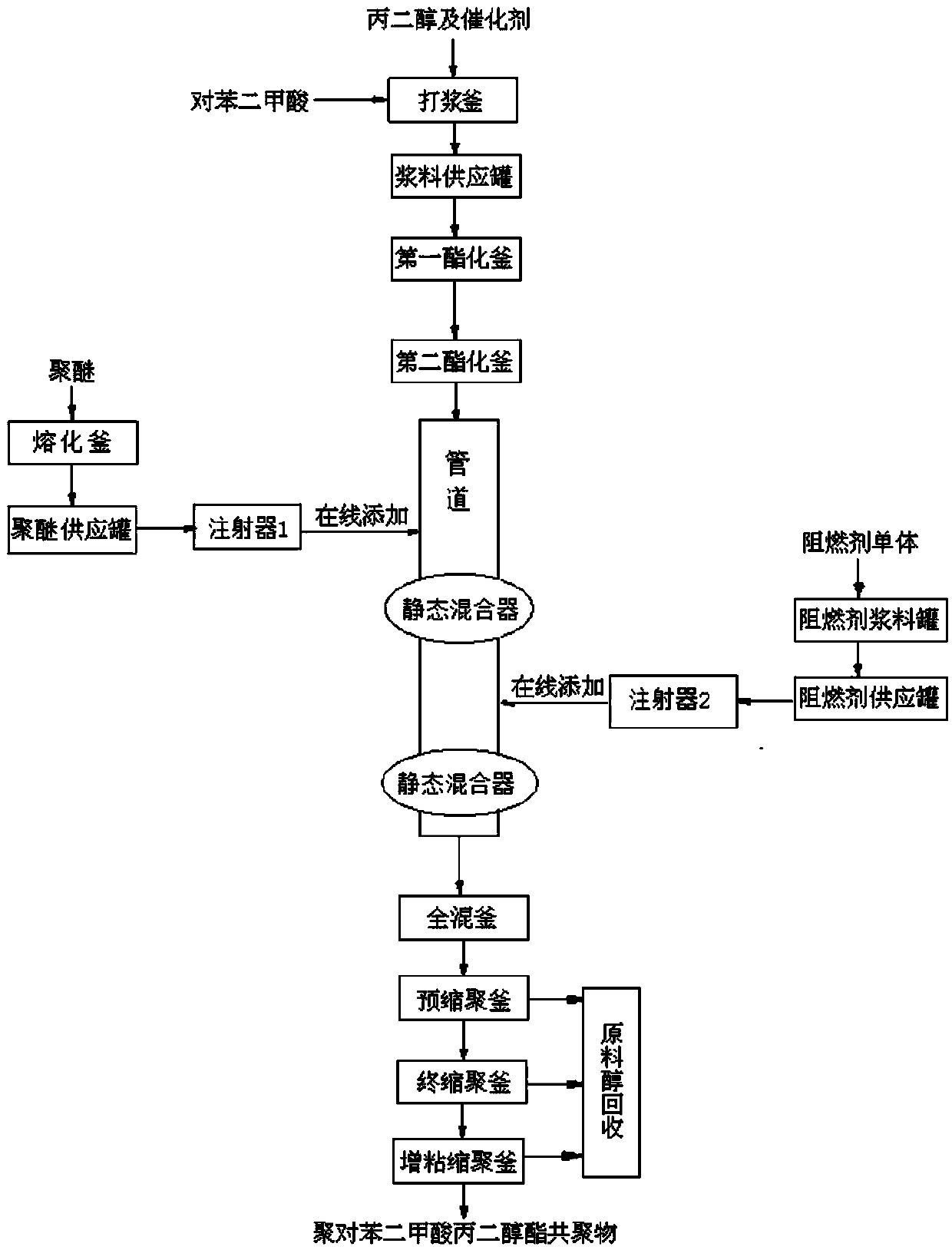Continuous polymerization preparation method of flame-retardant anti-static PTT (polytrimethylene terephthalate) polyester and polyester prepared by using same
A flame retardant, antistatic, PTT technology, applied in the field of polyester, can solve the problems of complex masterbatch preparation process, etc., and achieve the effects of easy large-scale industrial production, easy continuous operation, and strong market competitiveness
- Summary
- Abstract
- Description
- Claims
- Application Information
AI Technical Summary
Problems solved by technology
Method used
Image
Examples
Embodiment 1
[0064] 1. Put terephthalic acid (PTA) and propylene glycol (PDO) into the beating kettle, add tetrabutyl titanate for beating, beat for 40 minutes, and put it into the slurry supply tank; the molar ratio of terephthalic acid and propylene glycol is 1:1.5, the amount of tetrabutyl titanate added is 0.04% of the total reactant mass;
[0065] 2. Pump the slurry obtained in step 1 into the first esterification tank to carry out the esterification reaction. The esterification temperature is 250-255°C, and the flow rate is controlled so that after passing through the first esterification tank, the esterification rate is 85-255°C. 90%; then enter the second esterification kettle, the esterification temperature is 257-260°C, and the esterification rate is controlled at 97-98%; the obtained esterified product is pumped into the pipeline, and the pipeline passes through the injector 1 and the injector 2 in turn;
[0066] 3. Melt polyethylene glycol ether with a molecular weight of 1000 ...
Embodiment 2
[0072] 1. Put terephthalic acid (PTA) and propylene glycol (PDO) into the beating kettle, add tetraethyl propyl titanate for beating, beat for 30 minutes, and put it into the slurry supply tank; the molar ratio of terephthalic acid to propylene glycol The ratio is 1:1.5; the amount of tetraethylpropyl titanate added is 0.05% of the weight of PTT polyester;
[0073] 2. Pump the slurry obtained in step 1 into the first esterification tank to carry out the esterification reaction. The esterification temperature is 245-255°C, and the flow rate is controlled so that after passing through the first esterification tank, the esterification rate is 80-255°C. 90%; then enter the second esterification reaction kettle, the esterification temperature is 255-260°C, and the esterification rate is controlled at 97-98%; the obtained esterified product is pumped into the pipeline, and the pipeline passes through the injector 1 and the injector 2 in turn;
[0074] 3. Melt PTMG in the melting tan...
Embodiment 3
[0080] 1. Put terephthalic acid (PTA) and propylene glycol (PDO) into the beating kettle, add tetrabutyl titanate for beating, after beating for 50 minutes, put them into the slurry supply tank; the molar ratio of terephthalic acid to propylene glycol 1:1.5; the amount of esterification catalyst added is 0.03% of the weight of PTT polyester;
[0081] 2. Pump the slurry obtained in step 1 into the first esterification tank to carry out the esterification reaction. The esterification temperature is 245-255°C, and the flow rate is controlled so that after passing through the first esterification tank, the esterification rate is 85-255°C. 90%; then enter the second esterification reaction kettle, the esterification temperature is 255-260°C, and the esterification rate is controlled at 96-98%; the obtained esterified product is pumped into the pipeline, and then passes through the injector 1 and the injector 2 in turn;
[0082] 3. Mix 2-hydroxyethylphenylphosphinic acid with a cont...
PUM
| Property | Measurement | Unit |
|---|---|---|
| Intrinsic viscosity | aaaaa | aaaaa |
| Tensile strength | aaaaa | aaaaa |
| Melting point | aaaaa | aaaaa |
Abstract
Description
Claims
Application Information
 Login to View More
Login to View More - R&D
- Intellectual Property
- Life Sciences
- Materials
- Tech Scout
- Unparalleled Data Quality
- Higher Quality Content
- 60% Fewer Hallucinations
Browse by: Latest US Patents, China's latest patents, Technical Efficacy Thesaurus, Application Domain, Technology Topic, Popular Technical Reports.
© 2025 PatSnap. All rights reserved.Legal|Privacy policy|Modern Slavery Act Transparency Statement|Sitemap|About US| Contact US: help@patsnap.com

